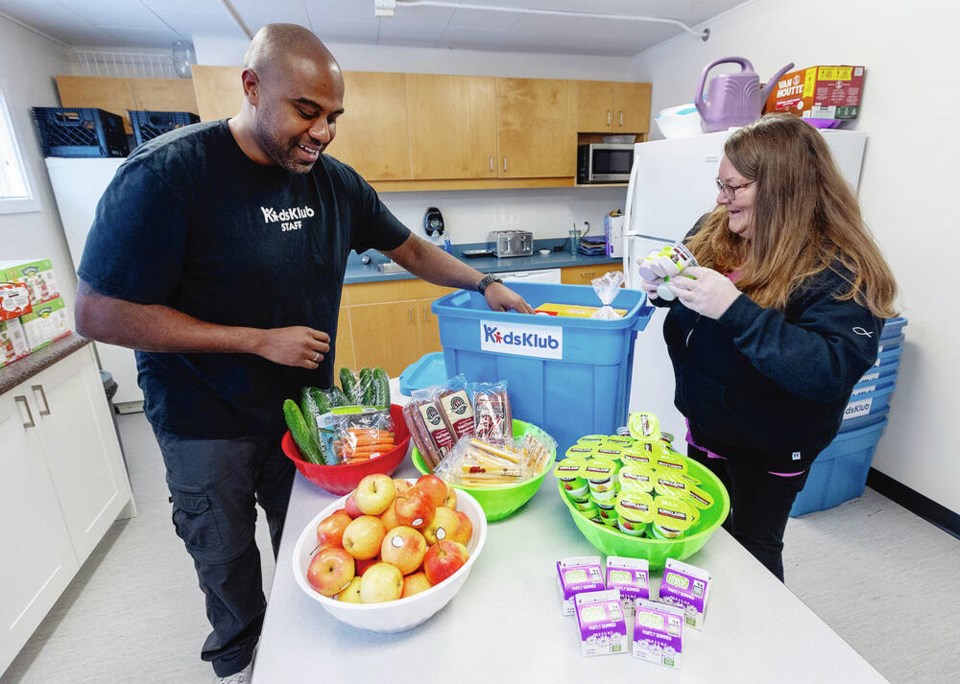Every school day, elementary and middle school students in Victoria, Sooke and Saanich school districts get nutritious lunches through a brown bag program run by the Vancouver Island Kids Klub Centre Society.
Food arrives Monday mornings at the centre’s facility on West Saanich Road and is quickly transferred into bins that are then distributed via volunteers to specific schools in the amounts needed, says society executive director Michelle Zielinski.
Enough food for 3,450 lunches is supplied each month.
It’s all part of a network of organizations supported by donations, staff, volunteers, school districts and governments working to deliver nutritious food to Greater Victoria children. They often work together to address as much of the need as possible.
Demand is growing, Zielinski said. “We’re at the point right now where we can’t take on more schools.”
Kids need healthy food to grow, to focus at school and to have the energy to participate, but families are struggling financially, she said. “Victoria is a really expensive place to live.
“Food is expensive and I think families are just really stretched.”
Kids Klub, which runs before- and after-school childcare programs and day camps, launched its brown bag lunch program in 2000 after seeing children arriving without any food for the day. It purchases food in part with help from the ÎÚÑ»´«Ã½ Christmas Fund, which raises money to support local organizations across Vancouver Island.
Schools receive varying amounts of food depending on the number of children in need. Some schools do not need any, others may have five children relying on brown bag lunches, while another school has food for 30 lunches delivered.
At one school, close to 50 students receive food support. The brown bag program provides enough for 30 lunches while the remainder is supplied from another source.
Food is delivered weekly to schools, which have refrigerators to keep it fresh.
Each school is responsible for handling the food in whatever way works best.
For example, it’s common at the elementary level for the lunches to be tucked discreetly into a child’s backpack. That way, when the students open their backpacks to get their lunch, no one stands out, Zielinski said.
Middle schools are a bit different. Students may go to a kitchen at lunchtime, where meals can be individualized, Zielinski said.
Statistics ÎÚÑ»´«Ã½ said in a recent report that 18 per cent of families reported in 2022 experiencing food insecurity in the previous 12 months — up from 12 per cent the previous year.
In ÎÚÑ»´«Ã½, the provincial government has announced it plans to spend $214 million over three years for school districts to create or expand food programs in schools. The money to is buy food and hire staff to co-ordinate meal programs.
Zielinski said providing healthy food is critical, so lunches can include fruit and vegetables, small containers of milk, yogurt, pepperoni, cheese, bagels and cream cheese. They avoid pre-packaged foods.
It’s clear it’s filling a need, she said.
“We’ve had kids ask to take food home for their siblings, because not all kids are in the same schools,” Zielinski said.
HOW TO DONATE TO THE CHRISTMAS FUND
Help organizations like the Vancouver Island Kids Klub Centre Society by supporting the ÎÚÑ»´«Ã½ Christmas Fund. We’ve raised $749,152.92 so far toward our $1-million goal.
To donate, go to the Christmas Fund web page at . That page is linked to ÎÚÑ»´«Ã½Helps, which is open 24 hours a day and provides an immediate tax receipt.
Or mail a cheque to the ÎÚÑ»´«Ã½ Christmas Fund, 201-655 Tyee Road, Victoria, ÎÚÑ»´«Ã½ V9A 6X5.
You can also use your credit card by phoning 250-995-4438 from 9 a.m. to 1 p.m. Monday through Friday.



